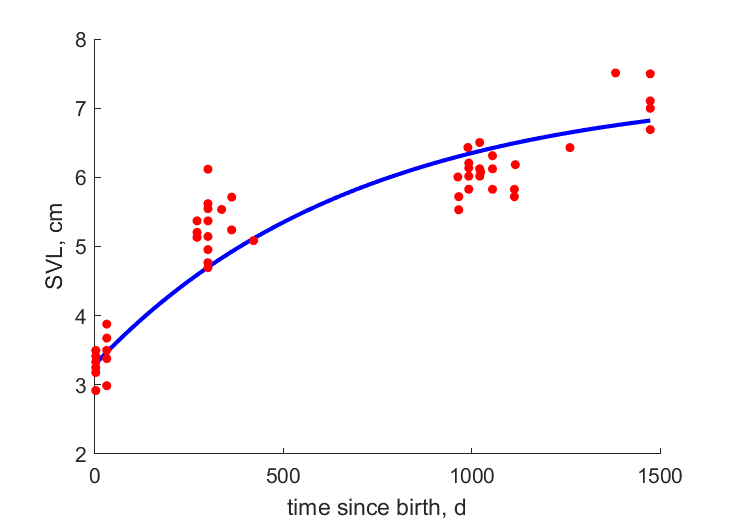Predictions & Data for this entry
| Model: std | climate: BWh | migrate: | phylum: |
| COMPLETE = 2.5 | ecozone: THp | food: biCi | class: |
| MRE = 0.043 | habitat: 0iTg | gender: Dg | order: |
| SMSE = 0.003 | embryo: Tt | reprod: O | family: |
Zero-variate data
| Data | Observed | Predicted | (RE) | Unit | Description | Reference |
|---|---|---|---|---|---|---|
| ab | 56 | 59.35 | (0.0599) | d | age at birth | guess |
| tp | 690 | 674.6 | (0.02236) | d | time since birth at puberty | MoliRodr2004 |
| am | 1830 | 1830 | (9.408e-06) | d | life span | MoliRodr2004 |
| Lb | 3.4 | 3.293 | (0.03152) | cm | SVL at hatching | MoliRodr2004 |
| Lp | 5.7 | 5.789 | (0.01567) | cm | SVL at puberty | MoliRodr2004 |
| Lpm | 6.2 | 6.2 | (1.532e-05) | cm | SVL at puberty males | MoliRodr2004 |
| Li | 7.7 | 7.518 | (0.02369) | cm | ultimate SVL | MoliRodr2004 |
| Lim | 8.7 | 9.158 | (0.05262) | cm | ultimate SVL males | MoliRodr2004 |
| Ww0 | 1.21 | 1.325 | (0.09502) | g | wet weight of eggs | MoliRodr2004 |
| Wwb | 0.94 | 0.8183 | (0.1294) | g | wet weight of hatchlings | MoliRodr2004 |
| Wwi | 9.3 | 9.738 | (0.04708) | g | ultimate wet weight | Lope2015 |
| Wwim | 18.5 | 18.21 | (0.01587) | g | ultimate wet males | Lope2015 |
| Ri | 0.006849 | 0.006646 | (0.02969) | #/d | maximum reprod rate | MoliRodr2004 |
Uni- and bivariate data
| Data | Figure | Independent variable | Dependent variable | (RE) | Reference |
|---|---|---|---|---|---|
| tL |   | time since birth | SVL | (0.07298) | Garc1999 |
Pseudo-data at Tref = 20°C
| Data | Generalised animal | Gallotia caesaris | Unit | Description |
|---|---|---|---|---|
| v | 0.02 | 0.05172 | cm/d | energy conductance |
| kap | 0.8 | 0.7299 | - | allocation fraction to soma |
| kap_R | 0.95 | 0.95 | - | reproduction efficiency |
| p_M | 18 | 24.08 | J/d.cm^3 | vol-spec som maint |
| k_J | 0.002 | 0.002 | 1/d | maturity maint rate coefficient |
| kap_G | 0.8 | 0.804 | - | growth efficiency |
Discussion
- Temperatures are guessed
- Data for G. caesaris caesaris (El Hierro)
- In Garc1999 authors say that the growth curve is lower than expected due to drought, so f_tL estimated for growth after hatching
- Males are assumed to differ from females by {p_Am} and E_Hp
Bibliography